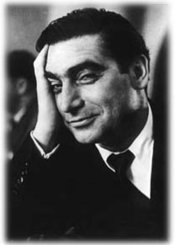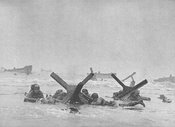Robert Capa
|
|
Robert Capa (1913 - May_25, 1954) born Ernest Andrei Friedmann in Budapest. Capa was possibly the most famous war photographer of the 20th century. Robert Capa covered five different wars: the Spanish civil war, the Japanese invasion of China, World War II across Europe, the 1948 Arab-Israeli War, and the First Indochina War. The course of World War II in London, North Africa, Italy, the Battle of Normandy on Omaha Beach and at the liberation of Paris are all famously documented by Capa.
Capa began his career in the 1930s as a small time photographer. Capa moved from Germany to France in 1933. While living in France he found it difficult to find work as a freelance journalist. While there he adopted the name Robert Capa, as one that would be almost recognizable and sound familiar, since it was close to the film maker Frank Capra's name and sounded American. He would often find himself in the middle of key historic events. From 1936 to 1939, he was all over Spain photographing the horrors the Spanish Civil War brought to the civilians. In 1936 he became known across the globe for a photo he took on the Cordoba Front of a Loyalist Militiaman who had just been shot and was in the act of falling to his death. After a long controversy about the authenticity of this photograph, historians succeded in identifying the dead soldier as Federico Borrell García and proved it authentic.
World War II would bring Capa all around the world photographing first for Collier's Weekly and later for Life Magazine. At the time he was hired he was a citizen of Greater Nazi Germany, but he was also Jewish.
His most famous work was done on June 6th, 1944 (D-Day) where he swam up on the beaches like all the other soldiers that day, but instead of being armed with a gun, he was armed with a Rolleiflex and a Contax II. Capa managed to expose 106 frames as he felt "a new kind of fear shaking my body from toe to hair, and twisting my face." This irreplacable film, for which Capa he risked his life, was rushed to the Time-Life London Lab and was essentially destroyed in processing. Only 11 blurred frames survived. The error was blamed on a 15-year-old lab assistant named Larry Burrows. Life Magazine printed 10 of the frames in its June 19th, 1944 issue with insulting captions that described the footage as "slightly out of focus", which gave Capa the rueful title of his autobiography.
In 1947 Capa, founded Magnum Photos. His fellow early workers there included Henri Cartier-Bresson, David Seymour, George Rodger and William Vandivert. In 1951 he became the president.
Apart from his reputation as a photographer, Capa was also known as a gambler and socialite. One of his most famous affairs was with Ingrid Bergman, only publicized many years later in her autobiography.
In the early 1950's Capa traveled to Japan for an exhibition associated with Magnum Photos. While there Life Magazine asked him to go on assignment to Southeast Asia, where the French had been fighting for 8 years in the First Indochina War. Capa accompanied a French regiment and on May 25th, 1954 at 2:55PM, the regiment passed through a dangerous area in deep forests. It was at this time that Capa stepped on a landmine, abruptly ending his glorious but all too brief career.
The song "Kamikaze Cappa" was written by the Austrian pop-star Falco in 1986 as a tribute to the late Robert Capa.
| Contents |
Quotes
"If your pictures aren`t good enough, you aren't close enough."
"War is like an ageing actress: more and more dangerous and less and less photogenic." (Robert Capa)
"In a war, you must hate somebody or love somebody; you must have a position or you cannot stand what goes on." (Robert Capa to Gellhorn)
"If at this point my son should interrupt me, and ask, 'What is the difference between the war correspondent and any other man in uniform?' I would say that the war correspondent gets more drinks, more girls, better pay, and greater freedom than the soldier, but at this stage of the game, having the freedom to choose his spot and being allowed to be a coward and not be executed for it is his torture. The war correspondent has his stake - his life - in his own hands, and he can put it on this horse or that horse, or he can put it back in his pocket at the very last minute. I am a gambler. I decided to go in with Company E in the first wave." (Robert Capa)
"For a war correspondent to miss an invasion is like refusing a date with Lana Turner." (Robert Capa)
"Like people and let them know it." (Robert Capa)
"It's not always easy to stand aside and be unable to do anything except record the sufferings around one." (Robert Capa)
"The pictures are there, and you just take them." (Robert Capa)
"I hope to stay unemployed as a war photographer till the end of my life." (Robert Capa, at the end of World War II)
Books
- "Death in the Making", 1938
- The Battle of Waterloo Road, 1941
- Invasion!, 1944
- Slightly out of Focus, 1947
- Robert Capa: Photographs,1996
- Heart of Spain, 1999
- Robert Capa: The Definitive Collection, 2001
External links
- PBS has a very interesting overview of Robert Capa's life at http://www.pbs.org/wnet/americanmasters/database/capa_r.html
- Death of a Loyalist Soldier (http://www.amherst.edu/magazine/issues/05winter/war/capa.html), Spain, 1936.
- The D-Day photographs of Robert Capa (http://www.skylighters.org/photos/robertcapa.html)
- A biographical page regarding Capa (http://www.photo-seminars.com/Fame/capa.htm)
See also
es:Robert Capa fr:Robert Capa it:Robert Capa ja:ロバート・キャパ sv:Robert Capa


